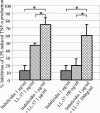Immunomodulatory activities of small host defense peptides
- PMID: 15855488
- PMCID: PMC1087655
- DOI: 10.1128/AAC.49.5.1727-1732.2005
Immunomodulatory activities of small host defense peptides
Abstract
Recent studies have demonstrated that in addition to their antimicrobial activity, cationic host defense peptides, like the human cathelicidin LL-37, perform many activities relating to innate immunity, including the induction or modulation of chemokine and cytokine production, alteration of gene expression in host cells, and inhibition of proinflammatory responses of host cells to bacterial components such as lipopolysaccharide (LPS) in vitro and in vivo. To investigate if these properties are shared by smaller peptides, two cathelicidin peptides derived from bovine neutrophils, the 13-mer indolicidin and Bac2A, a linear 12-amino-acid derivative of bactenecin, were compared to the 37-amino-acid peptide LL-37. Indolicidin, like LL-37, inhibited LPS-induced tumor necrosis factor alpha (TNF-alpha) secretion, even when added up to an hour after the addition of Escherichia coli O111:B4 LPS to the human macrophage/monocyte-like THP-1 cell line. In contrast, Bac2A demonstrated no significant antiendotoxin activity. At low concentrations, indolicidin and LL-37 acted synergistically to suppress LPS-induced production of TNF-alpha. Indolicidin was analogous to LL-37 in its ability to induce the production of the chemokine interleukin-8 (IL-8) in a human bronchial cell line, 16HBE14o(-), but it was unable to induce production of IL-8 in THP-1 cells. In contrast, Bac2A was unable to induce IL-8 in either cell type. Conversely, Bac2A was chemotactic for THP-1 cells at concentrations between 10 and 100 mug/ml, while indolicidin and LL-37 were not chemotactic at these concentrations for THP-1 cells. This indicates that in addition to the potential for direct microbicidal activity, cationic host defense peptides may have diverse and complementary abilities to modulate the innate immune response.
Figures





Similar articles
-
The innate defense regulator peptides IDR-HH2, IDR-1002, and IDR-1018 modulate human neutrophil functions.J Leukoc Biol. 2013 Jul;94(1):159-70. doi: 10.1189/jlb.1012497. Epub 2013 Apr 24. J Leukoc Biol. 2013. PMID: 23616580
-
Bovine and human cathelicidin cationic host defense peptides similarly suppress transcriptional responses to bacterial lipopolysaccharide.J Leukoc Biol. 2006 Dec;80(6):1563-74. doi: 10.1189/jlb.0106048. Epub 2006 Aug 30. J Leukoc Biol. 2006. PMID: 16943385
-
Synthetic cationic peptide IDR-1002 provides protection against bacterial infections through chemokine induction and enhanced leukocyte recruitment.J Immunol. 2010 Mar 1;184(5):2539-50. doi: 10.4049/jimmunol.0901813. Epub 2010 Jan 27. J Immunol. 2010. PMID: 20107187
-
Cathelicidin LL-37: a multitask antimicrobial peptide.Arch Immunol Ther Exp (Warsz). 2010 Feb;58(1):15-25. doi: 10.1007/s00005-009-0057-2. Epub 2010 Jan 5. Arch Immunol Ther Exp (Warsz). 2010. PMID: 20049649 Review.
-
Immunomodulatory properties of defensins and cathelicidins.Curr Top Microbiol Immunol. 2006;306:27-66. doi: 10.1007/3-540-29916-5_2. Curr Top Microbiol Immunol. 2006. PMID: 16909917 Free PMC article. Review.
Cited by
-
Rational design of engineered cationic antimicrobial peptides consisting exclusively of arginine and tryptophan, and their activity against multidrug-resistant pathogens.Antimicrob Agents Chemother. 2013 Jun;57(6):2511-21. doi: 10.1128/AAC.02218-12. Epub 2013 Mar 18. Antimicrob Agents Chemother. 2013. PMID: 23507278 Free PMC article.
-
Effect of vitamin D supplementation on Mycobacterium tuberculosis-induced innate immune responses in a Canadian Dené First Nations cohort.PLoS One. 2012;7(7):e40692. doi: 10.1371/journal.pone.0040692. Epub 2012 Jul 16. PLoS One. 2012. PMID: 22866178 Free PMC article.
-
Novel therapeutic interventions towards improved management of septic arthritis.BMC Musculoskelet Disord. 2021 Jun 9;22(1):530. doi: 10.1186/s12891-021-04383-6. BMC Musculoskelet Disord. 2021. PMID: 34107951 Free PMC article. Review.
-
Human beta-defensin 3 inhibits cell wall biosynthesis in Staphylococci.Infect Immun. 2010 Jun;78(6):2793-800. doi: 10.1128/IAI.00688-09. Epub 2010 Apr 12. Infect Immun. 2010. PMID: 20385753 Free PMC article.
-
Association of a genetic polymorphism (-44 C/G SNP) in the human DEFB1 gene with expression and inducibility of multiple beta-defensins in gingival keratinocytes.BMC Oral Health. 2009 Aug 27;9:21. doi: 10.1186/1472-6831-9-21. BMC Oral Health. 2009. PMID: 19712472 Free PMC article.
References
-
- Bowdish, D. M. E., D. J. Davidson, and R. E. W. Hancock. 2005. A re-evaluation of the role of host defence peptides in mammalian immunity. Curr. Protein Pept. Sci. 6:35-51. - PubMed
-
- Bowdish, D. M. E., D. J. Davidson, D. P. Speert, and R. E. W. Hancock. 2004. The human cationic peptide LL-37 induces activation of the extracellular signal-regulated kinase and p38 kinase pathways in primary human monocytes. J. Immunol. 172:3758-3765. - PubMed
-
- Ciornei, C. D., A. Egesten, M. Engstrom, K. Tornebrandt, and M. Bodelsson. 2002. Bactericidal/permeability-increasing protein inhibits endotoxin-induced vascular nitric oxide synthesis. Acta Anaesthesiol. Scand. 46:1111-1118. - PubMed
-
- Cozens, A. L., M. J. Yezzi, K. Kunzelmann, T. Ohrui, L. Chin, K. Eng, W. E. Finkbeiner, J. H. Widdicombe, and D. C. Gruenert. 1994. CFTR expression and chloride secretion in polarized immortal human bronchial epithelial cells. Am. J. Respir. Cell Mol. Biol. 10:38-47. - PubMed
-
- De, Y., Q. Chen, A. P. Schmidt, G. M. Anderson, J. M. Wang, J. Wooters, J. J. Oppenheim, and O. Chertov. 2000. LL-37, the neutrophil granule- and epithelial cell-derived cathelicidin, utilizes formyl peptide receptor-like 1 (FPRL1) as a receptor to chemoattract human peripheral blood neutrophils, monocytes, and T cells. J. Exp. Med. 192:1069-1074. - PMC - PubMed
Publication types
MeSH terms
Substances
LinkOut - more resources
Full Text Sources
Other Literature Sources
Miscellaneous

